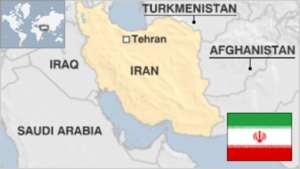In news- Recently, Iran has unveiled a new missile called Khaibar-buster, with a reported range that would allow it to reach both US bases in the region as well as targets inside its archfoe Israel.
About Khaibar-buster missile-
- The missile uses solid fuel and has a range of 1,450 kilometers, or 900 miles.
- It is called the Khaibar-buster, a reference to a Jewish castle overrun by Muslim warriors in the early days of Islam.
- This missile has high accuracy, is manufactured completely domestically, and can defeat missile shield systems.
- Israel’s closest point to Iran is some 1,000 kilometers (620 miles) away.
- Iran has missiles that can travel up to 2,000 kilometers, 1250 miles.
- Iran, which has long said it does not seek nuclear weapons, insists its missile program is only a deterrent.
- Earlier in January Iran tested an engine for a solid-fuel rocket designed to launch satellites.

About Iran-
- Persia, as Iran was known before 1935, was one of the greatest empires of the ancient world.
- It is bordered to the west by Iraq and Turkey, to the northwest by Azerbaijan and Armenia, to the north by the Caspian Sea and Turkmenistan, to the east by Afghanistan and Pakistan, and to the south by the Gulf of Oman and the Persian Gulf.
- By area, it is the fourth-largest country entirely in Asia and the second-largest in Western Asia.
- Its Capital and largest city is Tehran, Currency- Rial and its major language is Persian.
- It has long maintained a distinct cultural identity within the Islamic world by retaining its own language and adhering to the Shia interpretation of Islam.
- It became an Islamic republic in 1979, when the monarchy was overthrown and clerics assumed political control under supreme leader Ayatollah Khomeini.
- The Government of Iran is an Islamic theocracy which includes elements of a presidential democracy, with the ultimate authority vested in an autocratic “Supreme Leader”, a position held by Ali Khamenei since Khomeini’s death in 1989.
- The Iranian government is widely considered to be authoritarian.
- It is a founding member of the United Nations, the ECO, the OIC, and the OPEC.
- It has large reserves of fossil fuels—including the world’s second-largest natural gas supply and the fourth-largest proven oil reserves.
- Iran consists of the Iranian Plateau, with the exception of the coasts of the Caspian Sea and Khuzestan.
- Its northern part is covered by the lush lowland Caspian Hyrcanian mixed forests, located near the southern shores of the Caspian Sea.
- The eastern part consists mostly of desert basins, such as the Kavir Desert, which is the country’s largest desert, and the Lut Desert, as well as some salt lakes.
- It is one of the world’s most mountainous countries, its landscape dominated by rugged mountain ranges that separate various basins or plateaux from one another.
- The populous western part is the most mountainous, with ranges such as the Caucasus, Zagros, and Alborz, the last containing Mount Damavand, Iran’s highest point at 5,610 m (18,406 ft), which is also the highest mountain in Asia west of the Hindu Kush.
- Iran’s climate is diverse,ranging from arid and semi-arid, to subtropical along the Caspian coast and the northern forests.
















